Teys Australia Operations Management: Quality and Process Report
VerifiedAdded on 2023/06/05
|18
|4481
|57
Report
AI Summary
This report provides an analysis of operations management practices at Teys Australia, a prominent food manufacturing company. It begins with a progress report outlining the project's scope and completed work. The main report includes a company background, emphasizing Teys' presence in the competitive beef industry and its partnership with Cargill. A literature review on quality management highlights key stages and principles, including Total Quality Management (TQM). The report then applies the House of Quality (HoQ) framework to the company's meat products, identifying customer wants, product satisfaction methods, and the relationships between firm's 'hows.' Customer importance ratings are developed, and a competitive evaluation is conducted against brands like Sanderson Farms and Savencia Fromage & Dairy. Finally, the report touches on process and layout strategies, offering recommendations and a conclusion. Desklib provides access to this and other solved assignments for students.
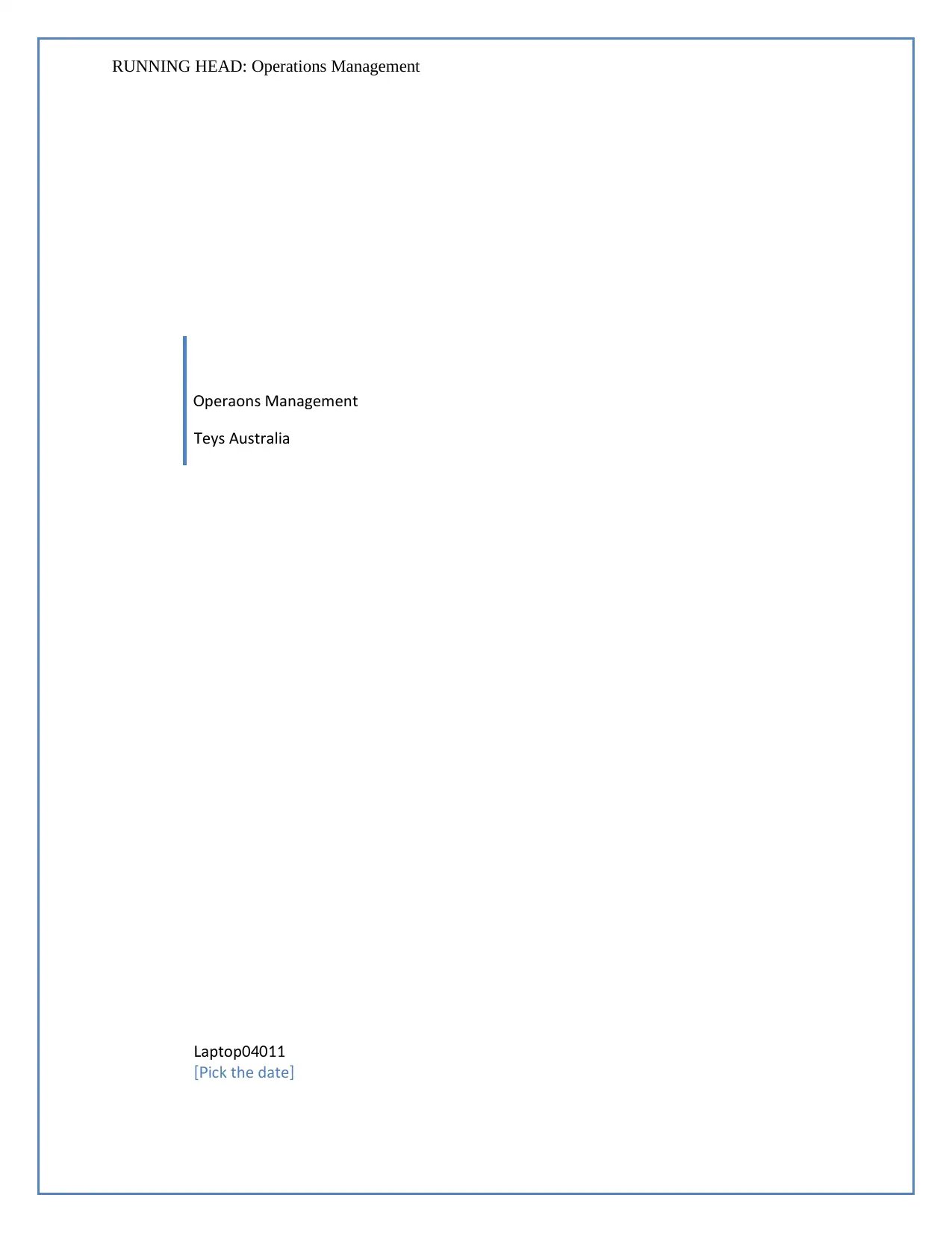
RUNNING HEAD: Operations Management
perations ManagementO
eys AustraliaT
aptopL 04011
[ ick the dateP ]
perations ManagementO
eys AustraliaT
aptopL 04011
[ ick the dateP ]
Paraphrase This Document
Need a fresh take? Get an instant paraphrase of this document with our AI Paraphraser
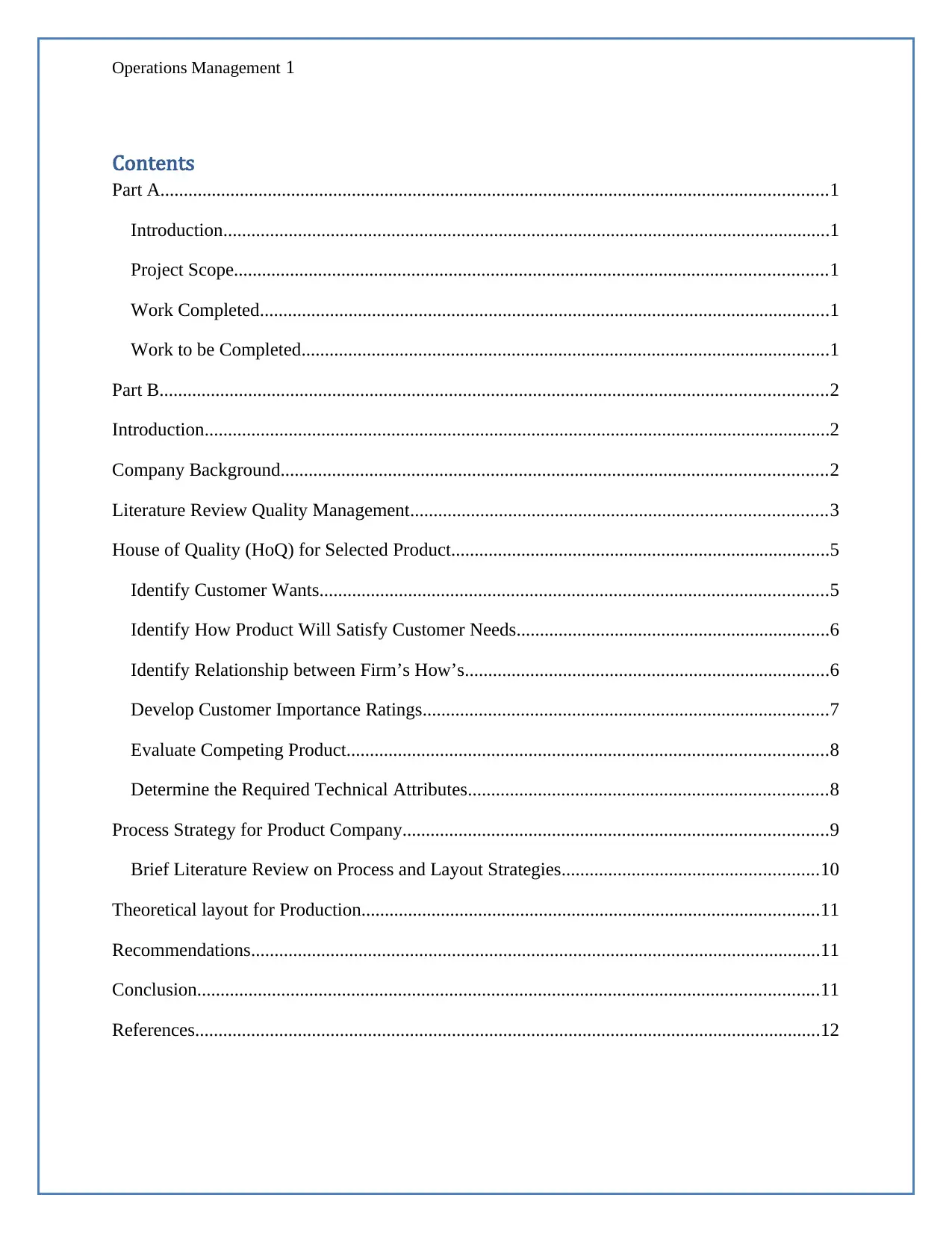
Operations Management 1
Contents
Part A...............................................................................................................................................1
Introduction..................................................................................................................................1
Project Scope...............................................................................................................................1
Work Completed..........................................................................................................................1
Work to be Completed.................................................................................................................1
Part B...............................................................................................................................................2
Introduction......................................................................................................................................2
Company Background.....................................................................................................................2
Literature Review Quality Management.........................................................................................3
House of Quality (HoQ) for Selected Product.................................................................................5
Identify Customer Wants.............................................................................................................5
Identify How Product Will Satisfy Customer Needs...................................................................6
Identify Relationship between Firm’s How’s..............................................................................6
Develop Customer Importance Ratings.......................................................................................7
Evaluate Competing Product.......................................................................................................8
Determine the Required Technical Attributes.............................................................................8
Process Strategy for Product Company...........................................................................................9
Brief Literature Review on Process and Layout Strategies.......................................................10
Theoretical layout for Production..................................................................................................11
Recommendations..........................................................................................................................11
Conclusion.....................................................................................................................................11
References......................................................................................................................................12
Contents
Part A...............................................................................................................................................1
Introduction..................................................................................................................................1
Project Scope...............................................................................................................................1
Work Completed..........................................................................................................................1
Work to be Completed.................................................................................................................1
Part B...............................................................................................................................................2
Introduction......................................................................................................................................2
Company Background.....................................................................................................................2
Literature Review Quality Management.........................................................................................3
House of Quality (HoQ) for Selected Product.................................................................................5
Identify Customer Wants.............................................................................................................5
Identify How Product Will Satisfy Customer Needs...................................................................6
Identify Relationship between Firm’s How’s..............................................................................6
Develop Customer Importance Ratings.......................................................................................7
Evaluate Competing Product.......................................................................................................8
Determine the Required Technical Attributes.............................................................................8
Process Strategy for Product Company...........................................................................................9
Brief Literature Review on Process and Layout Strategies.......................................................10
Theoretical layout for Production..................................................................................................11
Recommendations..........................................................................................................................11
Conclusion.....................................................................................................................................11
References......................................................................................................................................12

Operations Management 2
⊘ This is a preview!⊘
Do you want full access?
Subscribe today to unlock all pages.

Trusted by 1+ million students worldwide
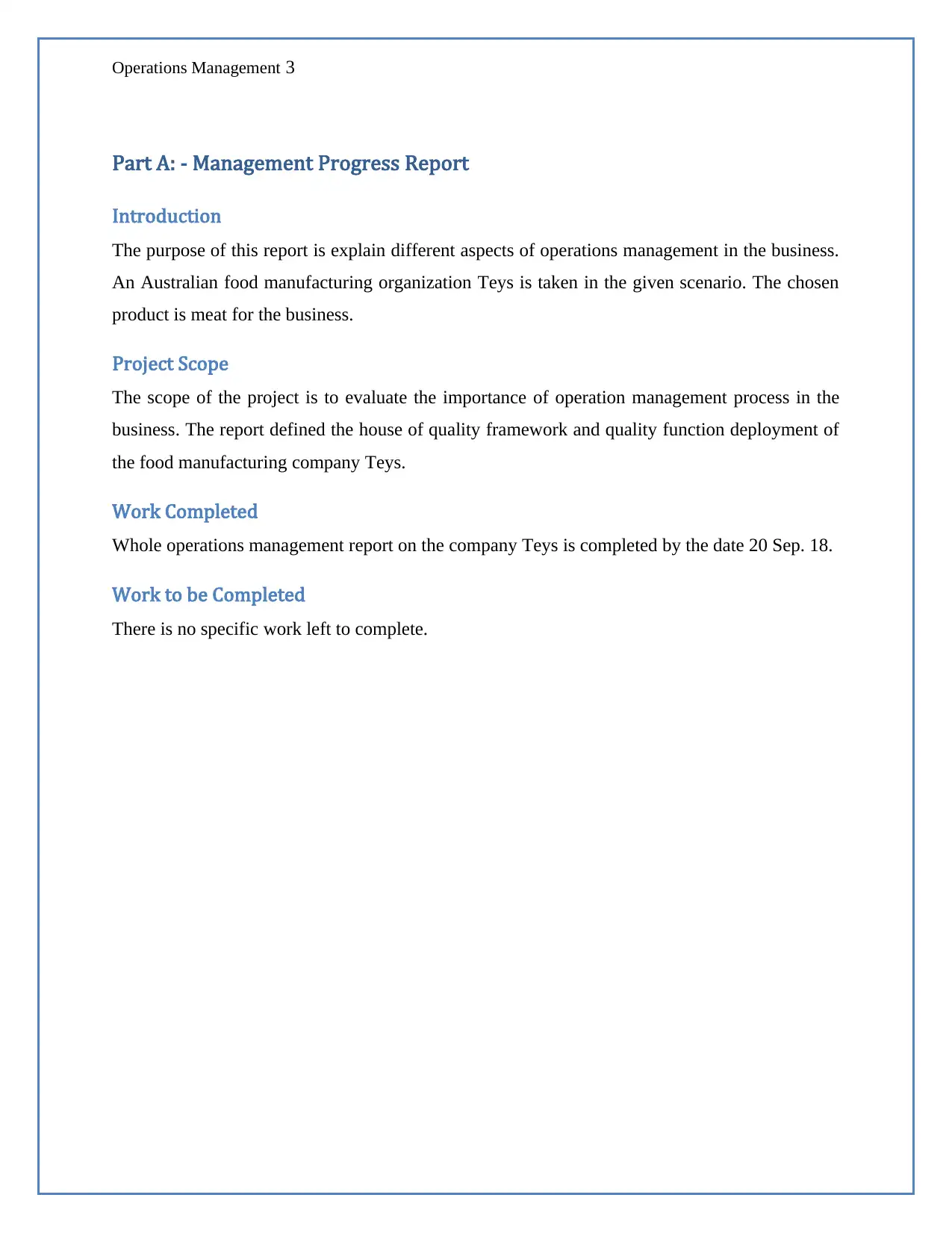
Operations Management 3
Part A: - Management Progress Report
Introduction
The purpose of this report is explain different aspects of operations management in the business.
An Australian food manufacturing organization Teys is taken in the given scenario. The chosen
product is meat for the business.
Project Scope
The scope of the project is to evaluate the importance of operation management process in the
business. The report defined the house of quality framework and quality function deployment of
the food manufacturing company Teys.
Work Completed
Whole operations management report on the company Teys is completed by the date 20 Sep. 18.
Work to be Completed
There is no specific work left to complete.
Part A: - Management Progress Report
Introduction
The purpose of this report is explain different aspects of operations management in the business.
An Australian food manufacturing organization Teys is taken in the given scenario. The chosen
product is meat for the business.
Project Scope
The scope of the project is to evaluate the importance of operation management process in the
business. The report defined the house of quality framework and quality function deployment of
the food manufacturing company Teys.
Work Completed
Whole operations management report on the company Teys is completed by the date 20 Sep. 18.
Work to be Completed
There is no specific work left to complete.
Paraphrase This Document
Need a fresh take? Get an instant paraphrase of this document with our AI Paraphraser
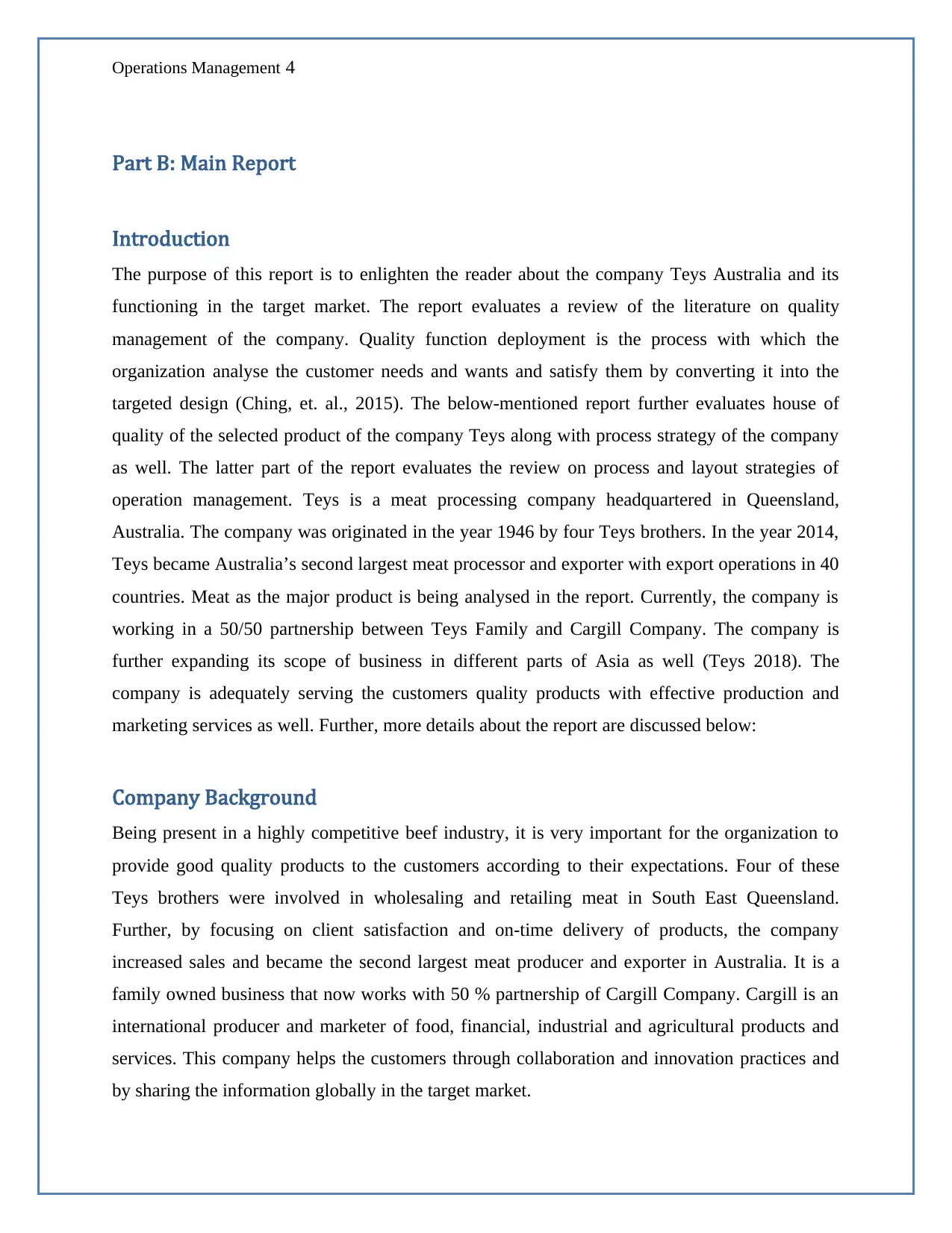
Operations Management 4
Part B: Main Report
Introduction
The purpose of this report is to enlighten the reader about the company Teys Australia and its
functioning in the target market. The report evaluates a review of the literature on quality
management of the company. Quality function deployment is the process with which the
organization analyse the customer needs and wants and satisfy them by converting it into the
targeted design (Ching, et. al., 2015). The below-mentioned report further evaluates house of
quality of the selected product of the company Teys along with process strategy of the company
as well. The latter part of the report evaluates the review on process and layout strategies of
operation management. Teys is a meat processing company headquartered in Queensland,
Australia. The company was originated in the year 1946 by four Teys brothers. In the year 2014,
Teys became Australia’s second largest meat processor and exporter with export operations in 40
countries. Meat as the major product is being analysed in the report. Currently, the company is
working in a 50/50 partnership between Teys Family and Cargill Company. The company is
further expanding its scope of business in different parts of Asia as well (Teys 2018). The
company is adequately serving the customers quality products with effective production and
marketing services as well. Further, more details about the report are discussed below:
Company Background
Being present in a highly competitive beef industry, it is very important for the organization to
provide good quality products to the customers according to their expectations. Four of these
Teys brothers were involved in wholesaling and retailing meat in South East Queensland.
Further, by focusing on client satisfaction and on-time delivery of products, the company
increased sales and became the second largest meat producer and exporter in Australia. It is a
family owned business that now works with 50 % partnership of Cargill Company. Cargill is an
international producer and marketer of food, financial, industrial and agricultural products and
services. This company helps the customers through collaboration and innovation practices and
by sharing the information globally in the target market.
Part B: Main Report
Introduction
The purpose of this report is to enlighten the reader about the company Teys Australia and its
functioning in the target market. The report evaluates a review of the literature on quality
management of the company. Quality function deployment is the process with which the
organization analyse the customer needs and wants and satisfy them by converting it into the
targeted design (Ching, et. al., 2015). The below-mentioned report further evaluates house of
quality of the selected product of the company Teys along with process strategy of the company
as well. The latter part of the report evaluates the review on process and layout strategies of
operation management. Teys is a meat processing company headquartered in Queensland,
Australia. The company was originated in the year 1946 by four Teys brothers. In the year 2014,
Teys became Australia’s second largest meat processor and exporter with export operations in 40
countries. Meat as the major product is being analysed in the report. Currently, the company is
working in a 50/50 partnership between Teys Family and Cargill Company. The company is
further expanding its scope of business in different parts of Asia as well (Teys 2018). The
company is adequately serving the customers quality products with effective production and
marketing services as well. Further, more details about the report are discussed below:
Company Background
Being present in a highly competitive beef industry, it is very important for the organization to
provide good quality products to the customers according to their expectations. Four of these
Teys brothers were involved in wholesaling and retailing meat in South East Queensland.
Further, by focusing on client satisfaction and on-time delivery of products, the company
increased sales and became the second largest meat producer and exporter in Australia. It is a
family owned business that now works with 50 % partnership of Cargill Company. Cargill is an
international producer and marketer of food, financial, industrial and agricultural products and
services. This company helps the customers through collaboration and innovation practices and
by sharing the information globally in the target market.
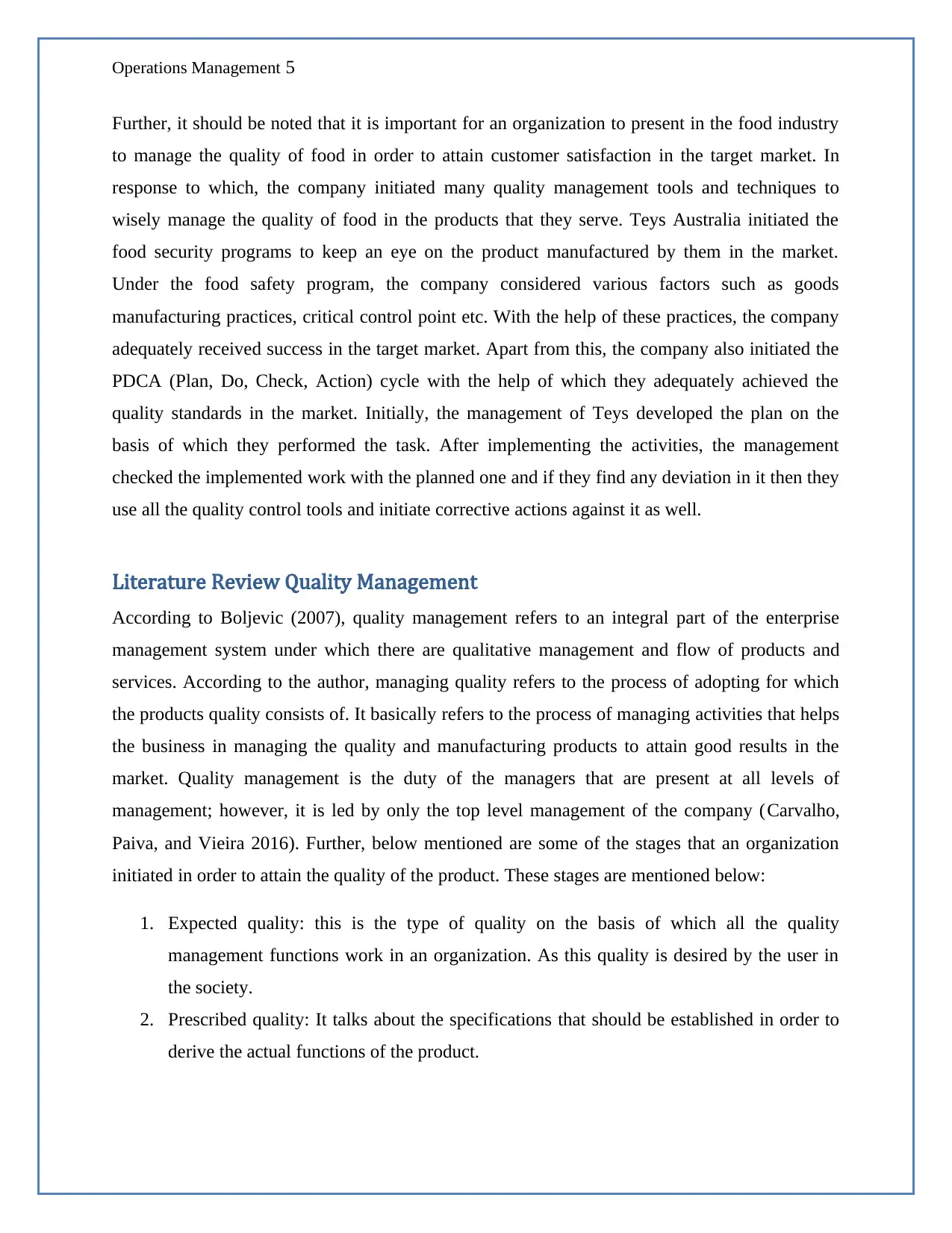
Operations Management 5
Further, it should be noted that it is important for an organization to present in the food industry
to manage the quality of food in order to attain customer satisfaction in the target market. In
response to which, the company initiated many quality management tools and techniques to
wisely manage the quality of food in the products that they serve. Teys Australia initiated the
food security programs to keep an eye on the product manufactured by them in the market.
Under the food safety program, the company considered various factors such as goods
manufacturing practices, critical control point etc. With the help of these practices, the company
adequately received success in the target market. Apart from this, the company also initiated the
PDCA (Plan, Do, Check, Action) cycle with the help of which they adequately achieved the
quality standards in the market. Initially, the management of Teys developed the plan on the
basis of which they performed the task. After implementing the activities, the management
checked the implemented work with the planned one and if they find any deviation in it then they
use all the quality control tools and initiate corrective actions against it as well.
Literature Review Quality Management
According to Boljevic (2007), quality management refers to an integral part of the enterprise
management system under which there are qualitative management and flow of products and
services. According to the author, managing quality refers to the process of adopting for which
the products quality consists of. It basically refers to the process of managing activities that helps
the business in managing the quality and manufacturing products to attain good results in the
market. Quality management is the duty of the managers that are present at all levels of
management; however, it is led by only the top level management of the company (Carvalho,
Paiva, and Vieira 2016). Further, below mentioned are some of the stages that an organization
initiated in order to attain the quality of the product. These stages are mentioned below:
1. Expected quality: this is the type of quality on the basis of which all the quality
management functions work in an organization. As this quality is desired by the user in
the society.
2. Prescribed quality: It talks about the specifications that should be established in order to
derive the actual functions of the product.
Further, it should be noted that it is important for an organization to present in the food industry
to manage the quality of food in order to attain customer satisfaction in the target market. In
response to which, the company initiated many quality management tools and techniques to
wisely manage the quality of food in the products that they serve. Teys Australia initiated the
food security programs to keep an eye on the product manufactured by them in the market.
Under the food safety program, the company considered various factors such as goods
manufacturing practices, critical control point etc. With the help of these practices, the company
adequately received success in the target market. Apart from this, the company also initiated the
PDCA (Plan, Do, Check, Action) cycle with the help of which they adequately achieved the
quality standards in the market. Initially, the management of Teys developed the plan on the
basis of which they performed the task. After implementing the activities, the management
checked the implemented work with the planned one and if they find any deviation in it then they
use all the quality control tools and initiate corrective actions against it as well.
Literature Review Quality Management
According to Boljevic (2007), quality management refers to an integral part of the enterprise
management system under which there are qualitative management and flow of products and
services. According to the author, managing quality refers to the process of adopting for which
the products quality consists of. It basically refers to the process of managing activities that helps
the business in managing the quality and manufacturing products to attain good results in the
market. Quality management is the duty of the managers that are present at all levels of
management; however, it is led by only the top level management of the company (Carvalho,
Paiva, and Vieira 2016). Further, below mentioned are some of the stages that an organization
initiated in order to attain the quality of the product. These stages are mentioned below:
1. Expected quality: this is the type of quality on the basis of which all the quality
management functions work in an organization. As this quality is desired by the user in
the society.
2. Prescribed quality: It talks about the specifications that should be established in order to
derive the actual functions of the product.
⊘ This is a preview!⊘
Do you want full access?
Subscribe today to unlock all pages.

Trusted by 1+ million students worldwide
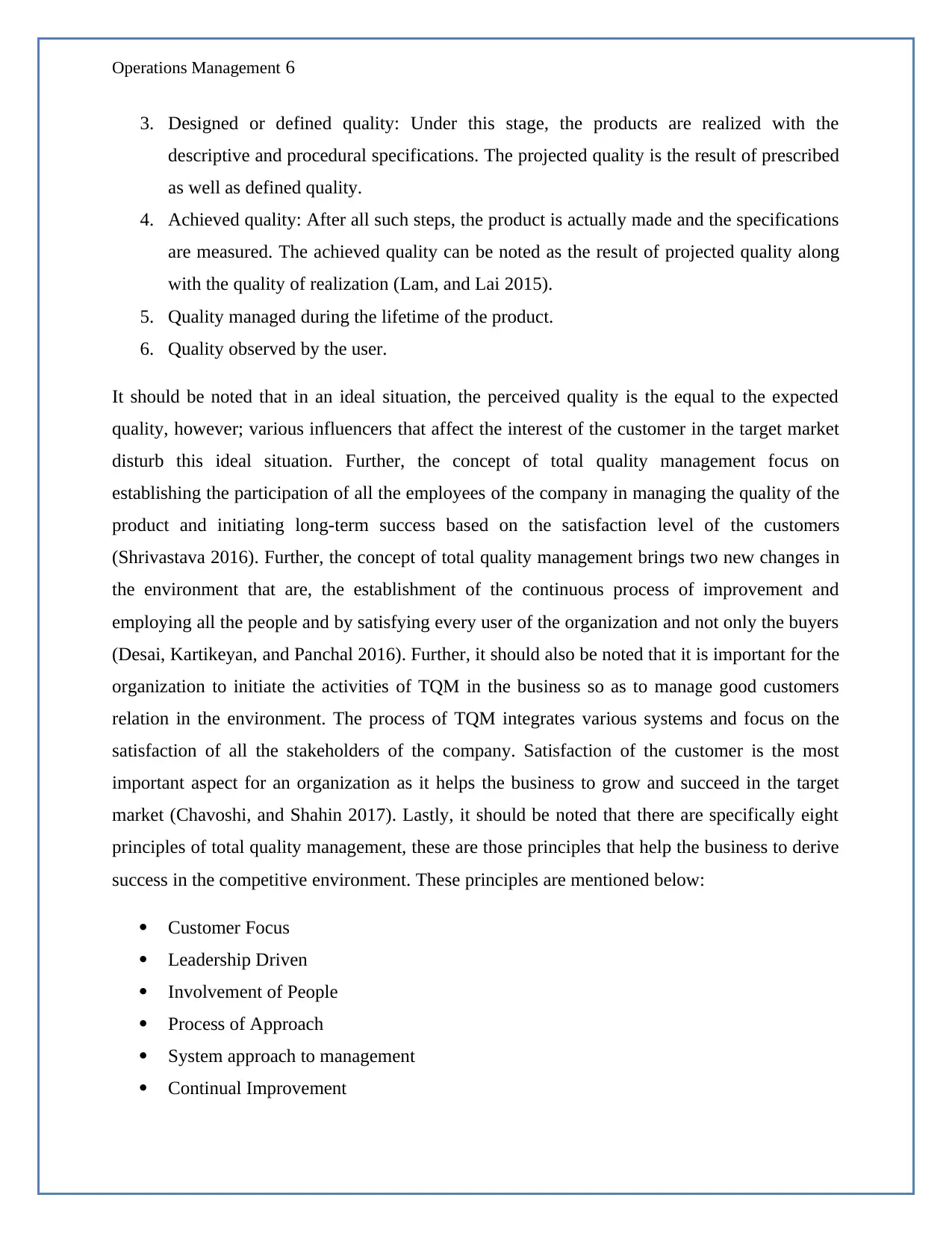
Operations Management 6
3. Designed or defined quality: Under this stage, the products are realized with the
descriptive and procedural specifications. The projected quality is the result of prescribed
as well as defined quality.
4. Achieved quality: After all such steps, the product is actually made and the specifications
are measured. The achieved quality can be noted as the result of projected quality along
with the quality of realization (Lam, and Lai 2015).
5. Quality managed during the lifetime of the product.
6. Quality observed by the user.
It should be noted that in an ideal situation, the perceived quality is the equal to the expected
quality, however; various influencers that affect the interest of the customer in the target market
disturb this ideal situation. Further, the concept of total quality management focus on
establishing the participation of all the employees of the company in managing the quality of the
product and initiating long-term success based on the satisfaction level of the customers
(Shrivastava 2016). Further, the concept of total quality management brings two new changes in
the environment that are, the establishment of the continuous process of improvement and
employing all the people and by satisfying every user of the organization and not only the buyers
(Desai, Kartikeyan, and Panchal 2016). Further, it should also be noted that it is important for the
organization to initiate the activities of TQM in the business so as to manage good customers
relation in the environment. The process of TQM integrates various systems and focus on the
satisfaction of all the stakeholders of the company. Satisfaction of the customer is the most
important aspect for an organization as it helps the business to grow and succeed in the target
market (Chavoshi, and Shahin 2017). Lastly, it should be noted that there are specifically eight
principles of total quality management, these are those principles that help the business to derive
success in the competitive environment. These principles are mentioned below:
Customer Focus
Leadership Driven
Involvement of People
Process of Approach
System approach to management
Continual Improvement
3. Designed or defined quality: Under this stage, the products are realized with the
descriptive and procedural specifications. The projected quality is the result of prescribed
as well as defined quality.
4. Achieved quality: After all such steps, the product is actually made and the specifications
are measured. The achieved quality can be noted as the result of projected quality along
with the quality of realization (Lam, and Lai 2015).
5. Quality managed during the lifetime of the product.
6. Quality observed by the user.
It should be noted that in an ideal situation, the perceived quality is the equal to the expected
quality, however; various influencers that affect the interest of the customer in the target market
disturb this ideal situation. Further, the concept of total quality management focus on
establishing the participation of all the employees of the company in managing the quality of the
product and initiating long-term success based on the satisfaction level of the customers
(Shrivastava 2016). Further, the concept of total quality management brings two new changes in
the environment that are, the establishment of the continuous process of improvement and
employing all the people and by satisfying every user of the organization and not only the buyers
(Desai, Kartikeyan, and Panchal 2016). Further, it should also be noted that it is important for the
organization to initiate the activities of TQM in the business so as to manage good customers
relation in the environment. The process of TQM integrates various systems and focus on the
satisfaction of all the stakeholders of the company. Satisfaction of the customer is the most
important aspect for an organization as it helps the business to grow and succeed in the target
market (Chavoshi, and Shahin 2017). Lastly, it should be noted that there are specifically eight
principles of total quality management, these are those principles that help the business to derive
success in the competitive environment. These principles are mentioned below:
Customer Focus
Leadership Driven
Involvement of People
Process of Approach
System approach to management
Continual Improvement
Paraphrase This Document
Need a fresh take? Get an instant paraphrase of this document with our AI Paraphraser
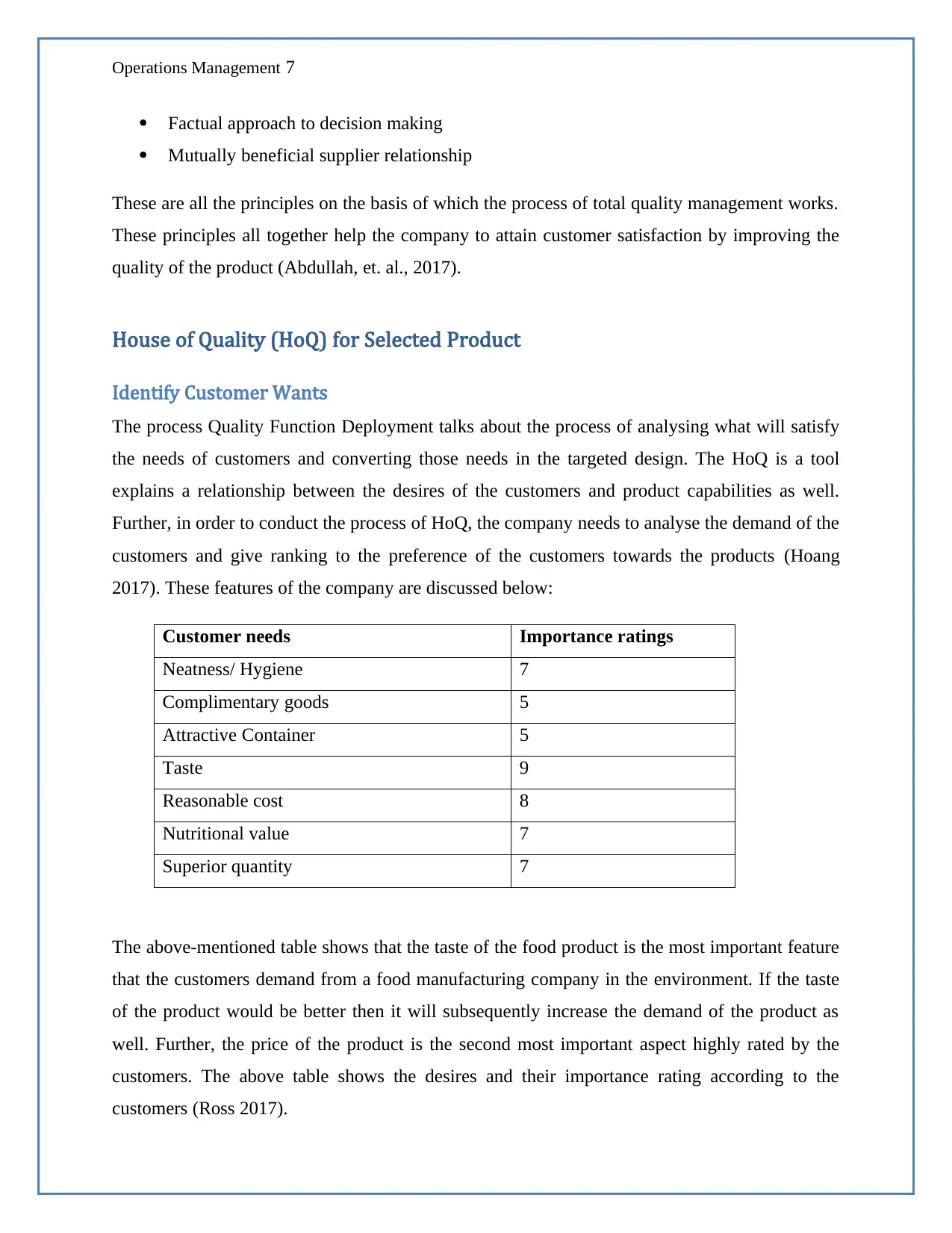
Operations Management 7
Factual approach to decision making
Mutually beneficial supplier relationship
These are all the principles on the basis of which the process of total quality management works.
These principles all together help the company to attain customer satisfaction by improving the
quality of the product (Abdullah, et. al., 2017).
House of Quality (HoQ) for Selected Product
Identify Customer Wants
The process Quality Function Deployment talks about the process of analysing what will satisfy
the needs of customers and converting those needs in the targeted design. The HoQ is a tool
explains a relationship between the desires of the customers and product capabilities as well.
Further, in order to conduct the process of HoQ, the company needs to analyse the demand of the
customers and give ranking to the preference of the customers towards the products (Hoang
2017). These features of the company are discussed below:
Customer needs Importance ratings
Neatness/ Hygiene 7
Complimentary goods 5
Attractive Container 5
Taste 9
Reasonable cost 8
Nutritional value 7
Superior quantity 7
The above-mentioned table shows that the taste of the food product is the most important feature
that the customers demand from a food manufacturing company in the environment. If the taste
of the product would be better then it will subsequently increase the demand of the product as
well. Further, the price of the product is the second most important aspect highly rated by the
customers. The above table shows the desires and their importance rating according to the
customers (Ross 2017).
Factual approach to decision making
Mutually beneficial supplier relationship
These are all the principles on the basis of which the process of total quality management works.
These principles all together help the company to attain customer satisfaction by improving the
quality of the product (Abdullah, et. al., 2017).
House of Quality (HoQ) for Selected Product
Identify Customer Wants
The process Quality Function Deployment talks about the process of analysing what will satisfy
the needs of customers and converting those needs in the targeted design. The HoQ is a tool
explains a relationship between the desires of the customers and product capabilities as well.
Further, in order to conduct the process of HoQ, the company needs to analyse the demand of the
customers and give ranking to the preference of the customers towards the products (Hoang
2017). These features of the company are discussed below:
Customer needs Importance ratings
Neatness/ Hygiene 7
Complimentary goods 5
Attractive Container 5
Taste 9
Reasonable cost 8
Nutritional value 7
Superior quantity 7
The above-mentioned table shows that the taste of the food product is the most important feature
that the customers demand from a food manufacturing company in the environment. If the taste
of the product would be better then it will subsequently increase the demand of the product as
well. Further, the price of the product is the second most important aspect highly rated by the
customers. The above table shows the desires and their importance rating according to the
customers (Ross 2017).
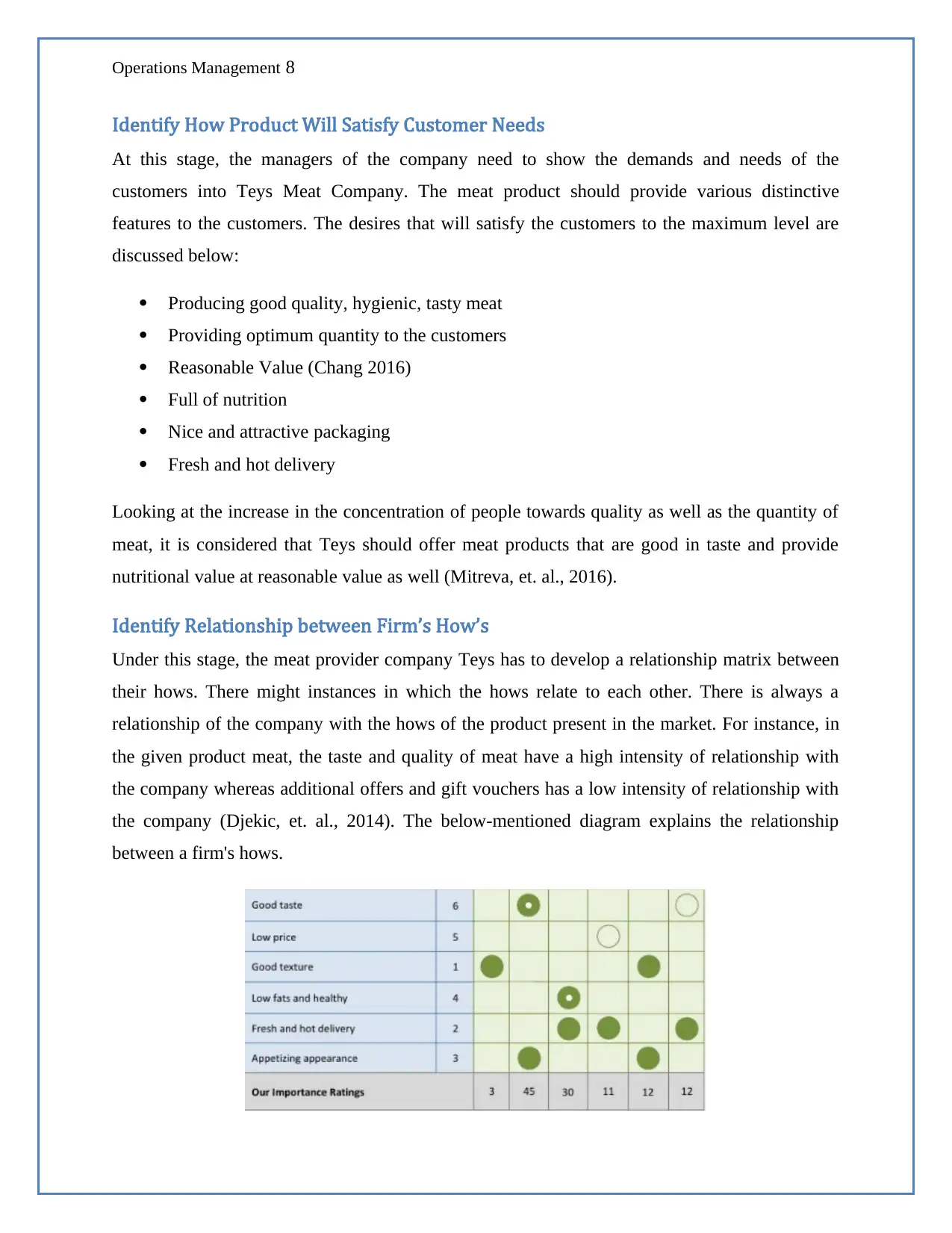
Operations Management 8
Identify How Product Will Satisfy Customer Needs
At this stage, the managers of the company need to show the demands and needs of the
customers into Teys Meat Company. The meat product should provide various distinctive
features to the customers. The desires that will satisfy the customers to the maximum level are
discussed below:
Producing good quality, hygienic, tasty meat
Providing optimum quantity to the customers
Reasonable Value (Chang 2016)
Full of nutrition
Nice and attractive packaging
Fresh and hot delivery
Looking at the increase in the concentration of people towards quality as well as the quantity of
meat, it is considered that Teys should offer meat products that are good in taste and provide
nutritional value at reasonable value as well (Mitreva, et. al., 2016).
Identify Relationship between Firm’s How’s
Under this stage, the meat provider company Teys has to develop a relationship matrix between
their hows. There might instances in which the hows relate to each other. There is always a
relationship of the company with the hows of the product present in the market. For instance, in
the given product meat, the taste and quality of meat have a high intensity of relationship with
the company whereas additional offers and gift vouchers has a low intensity of relationship with
the company (Djekic, et. al., 2014). The below-mentioned diagram explains the relationship
between a firm's hows.
Identify How Product Will Satisfy Customer Needs
At this stage, the managers of the company need to show the demands and needs of the
customers into Teys Meat Company. The meat product should provide various distinctive
features to the customers. The desires that will satisfy the customers to the maximum level are
discussed below:
Producing good quality, hygienic, tasty meat
Providing optimum quantity to the customers
Reasonable Value (Chang 2016)
Full of nutrition
Nice and attractive packaging
Fresh and hot delivery
Looking at the increase in the concentration of people towards quality as well as the quantity of
meat, it is considered that Teys should offer meat products that are good in taste and provide
nutritional value at reasonable value as well (Mitreva, et. al., 2016).
Identify Relationship between Firm’s How’s
Under this stage, the meat provider company Teys has to develop a relationship matrix between
their hows. There might instances in which the hows relate to each other. There is always a
relationship of the company with the hows of the product present in the market. For instance, in
the given product meat, the taste and quality of meat have a high intensity of relationship with
the company whereas additional offers and gift vouchers has a low intensity of relationship with
the company (Djekic, et. al., 2014). The below-mentioned diagram explains the relationship
between a firm's hows.
⊘ This is a preview!⊘
Do you want full access?
Subscribe today to unlock all pages.

Trusted by 1+ million students worldwide
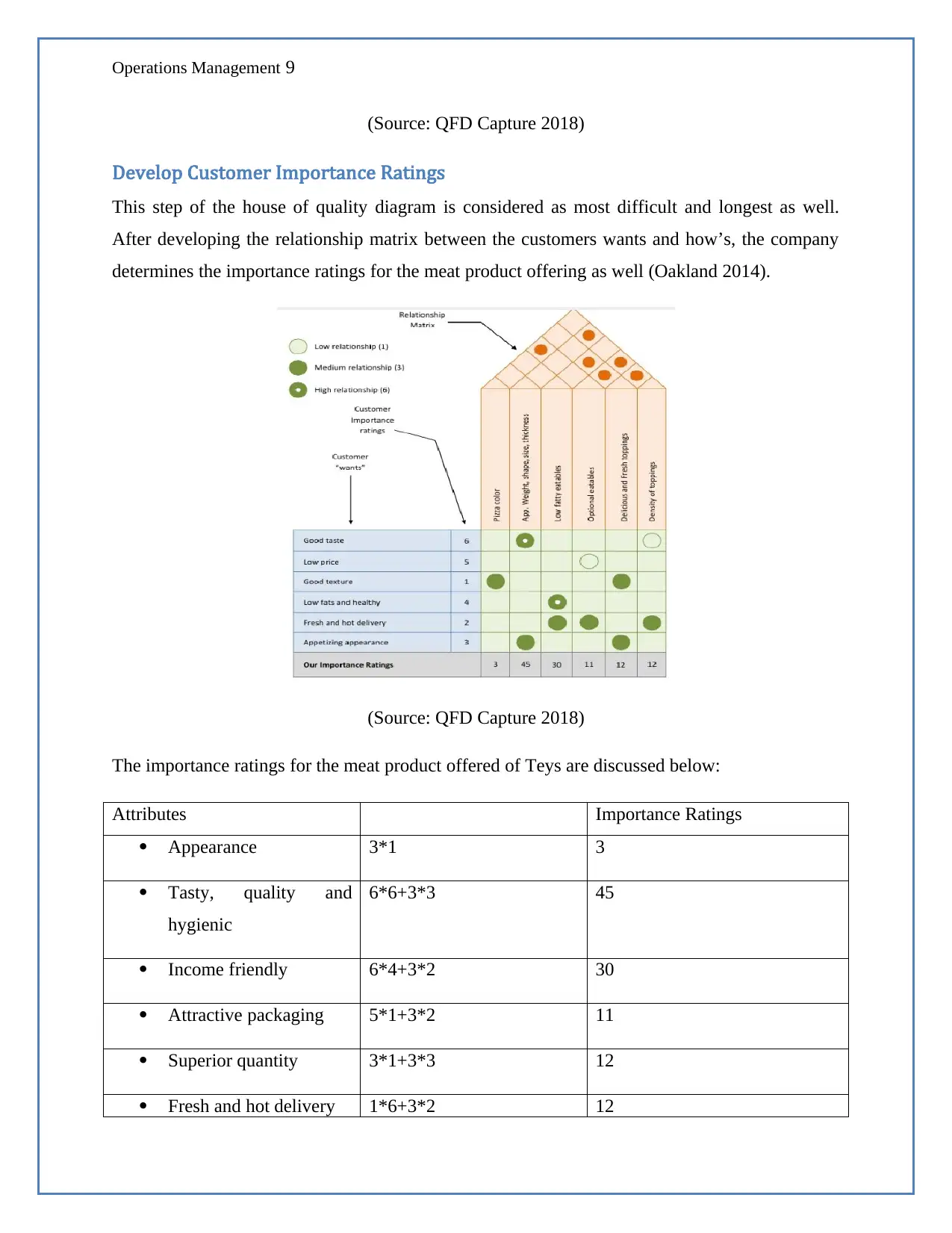
Operations Management 9
(Source: QFD Capture 2018)
Develop Customer Importance Ratings
This step of the house of quality diagram is considered as most difficult and longest as well.
After developing the relationship matrix between the customers wants and how’s, the company
determines the importance ratings for the meat product offering as well (Oakland 2014).
(Source: QFD Capture 2018)
The importance ratings for the meat product offered of Teys are discussed below:
Attributes Importance Ratings
Appearance 3*1 3
Tasty, quality and
hygienic
6*6+3*3 45
Income friendly 6*4+3*2 30
Attractive packaging 5*1+3*2 11
Superior quantity 3*1+3*3 12
Fresh and hot delivery 1*6+3*2 12
(Source: QFD Capture 2018)
Develop Customer Importance Ratings
This step of the house of quality diagram is considered as most difficult and longest as well.
After developing the relationship matrix between the customers wants and how’s, the company
determines the importance ratings for the meat product offering as well (Oakland 2014).
(Source: QFD Capture 2018)
The importance ratings for the meat product offered of Teys are discussed below:
Attributes Importance Ratings
Appearance 3*1 3
Tasty, quality and
hygienic
6*6+3*3 45
Income friendly 6*4+3*2 30
Attractive packaging 5*1+3*2 11
Superior quantity 3*1+3*3 12
Fresh and hot delivery 1*6+3*2 12
Paraphrase This Document
Need a fresh take? Get an instant paraphrase of this document with our AI Paraphraser
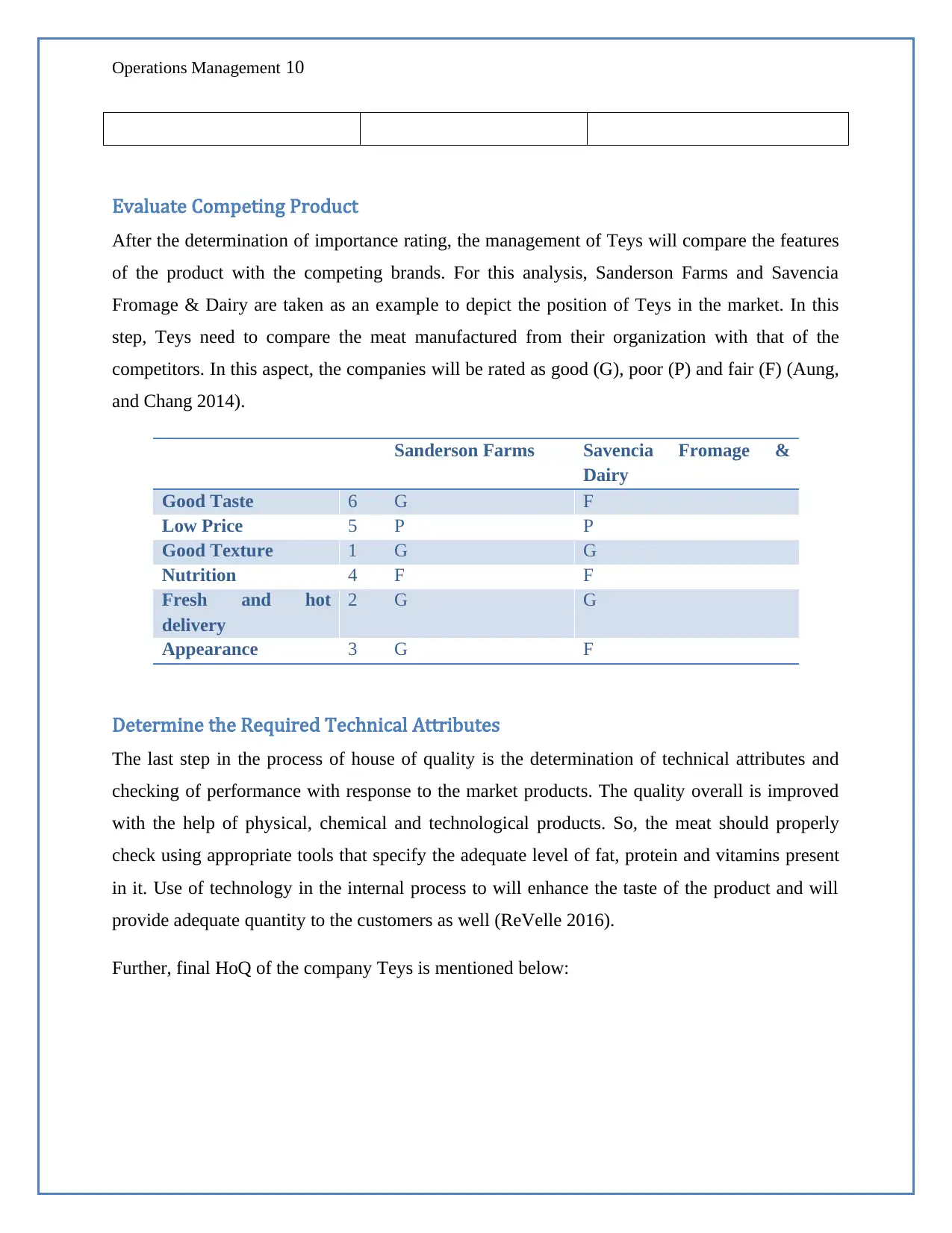
Operations Management 10
Evaluate Competing Product
After the determination of importance rating, the management of Teys will compare the features
of the product with the competing brands. For this analysis, Sanderson Farms and Savencia
Fromage & Dairy are taken as an example to depict the position of Teys in the market. In this
step, Teys need to compare the meat manufactured from their organization with that of the
competitors. In this aspect, the companies will be rated as good (G), poor (P) and fair (F) (Aung,
and Chang 2014).
Sanderson Farms Savencia Fromage &
Dairy
Good Taste 6 G F
Low Price 5 P P
Good Texture 1 G G
Nutrition 4 F F
Fresh and hot
delivery
2 G G
Appearance 3 G F
Determine the Required Technical Attributes
The last step in the process of house of quality is the determination of technical attributes and
checking of performance with response to the market products. The quality overall is improved
with the help of physical, chemical and technological products. So, the meat should properly
check using appropriate tools that specify the adequate level of fat, protein and vitamins present
in it. Use of technology in the internal process to will enhance the taste of the product and will
provide adequate quantity to the customers as well (ReVelle 2016).
Further, final HoQ of the company Teys is mentioned below:
Evaluate Competing Product
After the determination of importance rating, the management of Teys will compare the features
of the product with the competing brands. For this analysis, Sanderson Farms and Savencia
Fromage & Dairy are taken as an example to depict the position of Teys in the market. In this
step, Teys need to compare the meat manufactured from their organization with that of the
competitors. In this aspect, the companies will be rated as good (G), poor (P) and fair (F) (Aung,
and Chang 2014).
Sanderson Farms Savencia Fromage &
Dairy
Good Taste 6 G F
Low Price 5 P P
Good Texture 1 G G
Nutrition 4 F F
Fresh and hot
delivery
2 G G
Appearance 3 G F
Determine the Required Technical Attributes
The last step in the process of house of quality is the determination of technical attributes and
checking of performance with response to the market products. The quality overall is improved
with the help of physical, chemical and technological products. So, the meat should properly
check using appropriate tools that specify the adequate level of fat, protein and vitamins present
in it. Use of technology in the internal process to will enhance the taste of the product and will
provide adequate quantity to the customers as well (ReVelle 2016).
Further, final HoQ of the company Teys is mentioned below:
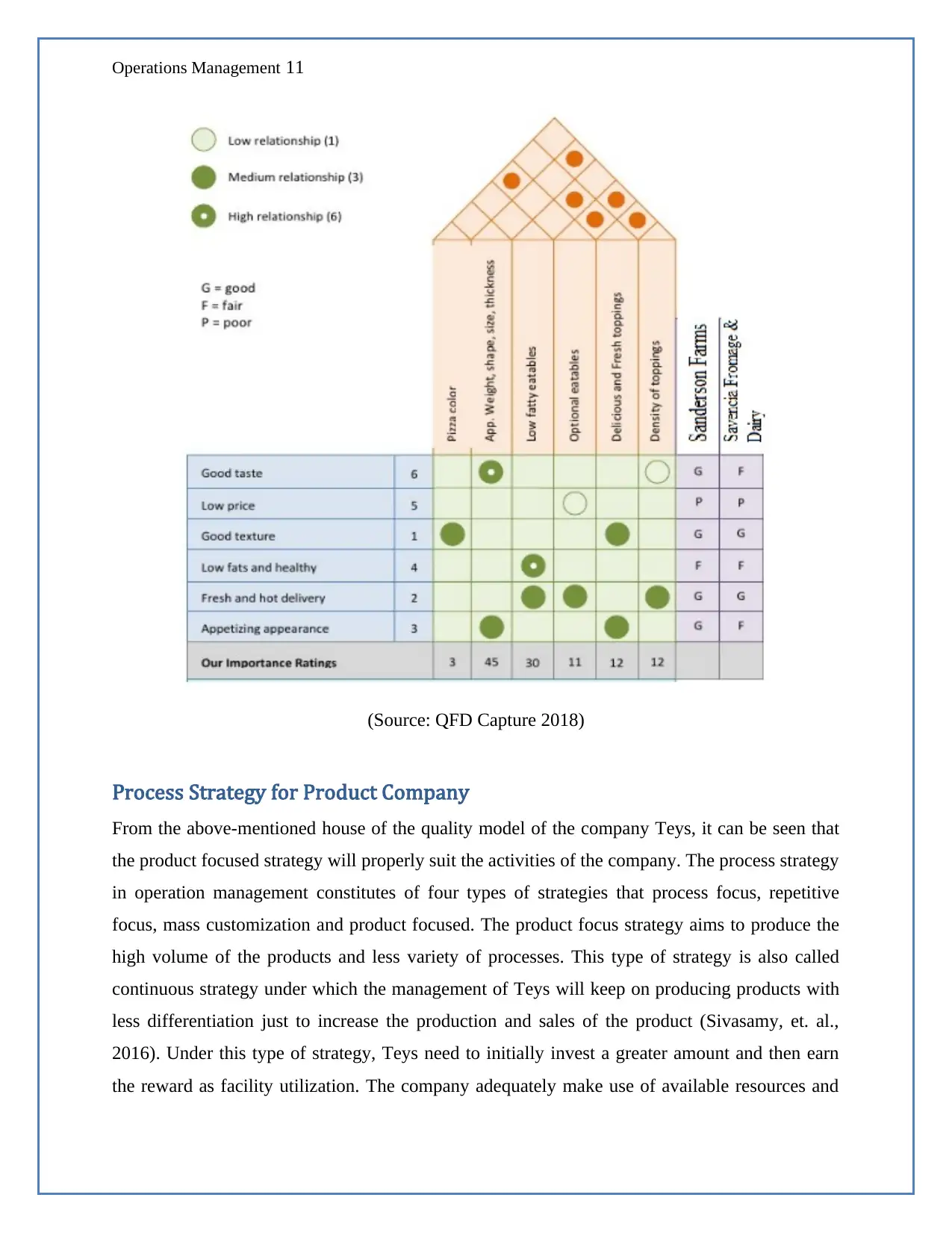
Operations Management 11
(Source: QFD Capture 2018)
Process Strategy for Product Company
From the above-mentioned house of the quality model of the company Teys, it can be seen that
the product focused strategy will properly suit the activities of the company. The process strategy
in operation management constitutes of four types of strategies that process focus, repetitive
focus, mass customization and product focused. The product focus strategy aims to produce the
high volume of the products and less variety of processes. This type of strategy is also called
continuous strategy under which the management of Teys will keep on producing products with
less differentiation just to increase the production and sales of the product (Sivasamy, et. al.,
2016). Under this type of strategy, Teys need to initially invest a greater amount and then earn
the reward as facility utilization. The company adequately make use of available resources and
(Source: QFD Capture 2018)
Process Strategy for Product Company
From the above-mentioned house of the quality model of the company Teys, it can be seen that
the product focused strategy will properly suit the activities of the company. The process strategy
in operation management constitutes of four types of strategies that process focus, repetitive
focus, mass customization and product focused. The product focus strategy aims to produce the
high volume of the products and less variety of processes. This type of strategy is also called
continuous strategy under which the management of Teys will keep on producing products with
less differentiation just to increase the production and sales of the product (Sivasamy, et. al.,
2016). Under this type of strategy, Teys need to initially invest a greater amount and then earn
the reward as facility utilization. The company adequately make use of available resources and
⊘ This is a preview!⊘
Do you want full access?
Subscribe today to unlock all pages.

Trusted by 1+ million students worldwide
1 out of 18
Related Documents
Your All-in-One AI-Powered Toolkit for Academic Success.
+13062052269
info@desklib.com
Available 24*7 on WhatsApp / Email
![[object Object]](/_next/static/media/star-bottom.7253800d.svg)
Unlock your academic potential
Copyright © 2020–2025 A2Z Services. All Rights Reserved. Developed and managed by ZUCOL.





